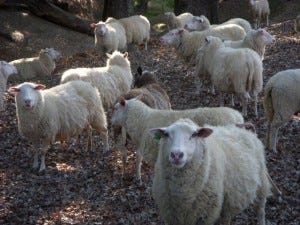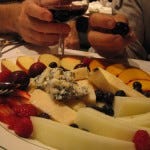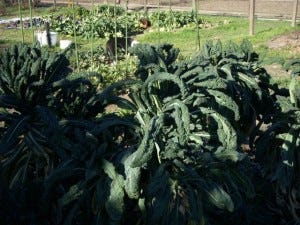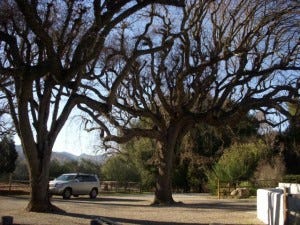Feeling Sheepish
1.16.09 Santa Margarita, CA I have always been a sheep’s cheese freak. It started with Manchego, when I lived in Spain for three years (you sometimes see cow’s-milk Manchego, or a blend, but sheep’s milk is the authentic cheese). Then I discovered Greek sheep’s cheese, which includes a whole lexicon above and beyond the it's-darned-good-too feta: Kasseri, Kefalotyri, and my most recent sublime discovery, Manouri (kind of like a blend of feta and mascarpone, if you can imagine that happy partnership). In the Hudson Valley, where I live when the weather is more clement than it is at the moment, we have Catskill Tomme, from the Dancing Lamb Farm and Icelandic Sheep Dairy (in Earlton, should you wish to visit when the sheep thaw out). Last year I was lucky enough to help New York City’s top-notch Greek chef Michael Psilakis write his first cookbook, so I got to eat and think about lots of sheepish cheeses. (Knowing me---Miss Fat Lover---the strong affinity I have for these characterful cheeses may stem from the fact that sheep’s milk is higher in butterfat and protein than that of cows or goats.)
So when cousin Robert said that he had a friend in Santa Margarita with a sheep dairy and farm-stay accommodations, I immediately phoned Christine Maguire, the cheesemaker at Rinconada Dairy, to set up a visit. This is a very busy woman, but she managed to fit us in between gardening, feeding animals, painting furniture for the barn apartment, caring for her two dogs and 20-something cats, and running the cheese business (her husband Jim has a day-job as a lawyer, and gets up early to take care of regular chores, but they have no full-time employees). In January, the sheep don’t need to be milked every day and there were no paying guests, so it was a “slow time.” We met the sheep and wandered around the property, chatting of a shared love for both cheese and California. These fifty-nine acres of lushly spare, oak-scattered hills, rocks, and hollows embody the mostly-departed California of my youth more than anywhere else in today’s over-built Golden State. The atmosphere is bucolic, but such a life is hard work. And when it comes to business, Mother Nature is a force to be reckoned with. Two years ago, Christine lost all 200 wheels of the year's cheese to an unexpected bacteria problem. It was then that she and Jim decided to convert the back of the house into a room and bath for paying guests (it was too big for just the two of them anyway, at almost 4000 square feet). The apartment in the barn followed.
“How do you market the farm-stays,” I asked, when she said they were booked up almost fulltime in the classic season for wine-country visits. “Some lady who said she was from the L.A. Times came for a tour. I didn’t think much about it, but all of a sudden there was a full-page spread, with color photos, in the paper.” That’s what I call laissez-faire marketing. You couldn't pay for that kind of exposure even if you could. The rules of the farm are firm (mostly), and allow the Maguires to maintain their privacy and the sanctity of their home: Guests receive breakfast in the morning, and a drink before dinner, but are strongly encouraged to tour the area during the day and find their own supper in one of the surrounding towns. It’s not really about working on the farm, either, but one guest was itching to get her hands dirty, so Christine put her to work weeding and trimming an ocean of lavender off the back patio, near the outdoor dining area and not far from the ample vegetable garden.
There was one instance when paying guests were offered dinner, and the story helps to define this no-nonsense, smart–and-savvy “farmer.” A couple---in their early seventies---had booked one of the rooms as the first stop after their marriage in the Central Valley-Bakersfield area. Their GPS led them, in its charming way, up hill, down dale, around the back, and under the radar. They felt lost and afraid and all alone, so that by the time they arrived at Rinconada---in the dark---the prospect of venturing out again to find dinner caused them to manifest a distinct deer-in-the-headlights look. That night, the newlyweds shared leftover meatloaf with Jim and Christina in the huge and warm butcher-block, soapstone, and hammered copper kitchen, where it is clear that some wonderful meals are often whipped up. “We’ve made a lot of wonderful friends since we started the farm-stays,” says Christine. No surprise there. And she and Jim are no faddish newcomers to the concept of producing food: for thirty years, she told me, they have tried to raise as much of their meat and produce as possible. And nothing goes to waste: when they discovered that the whey---which is a natural by-product of making cheese---went to waste, a pig was invited into the family, to eat the whey. It is now in the freezer.
When we left, Christine reached over and gave me a big hug. (Do not for a moment visualize a Mrs Fields type: this attractive, blonde, blue-jeaned woman would be equally at home teaching a class, writing a book, or running a multi-national business.) This is a lady who has found her perfect place in the world, and turned a boundless energy and humor towards making an estimable sheep’s cheese and running a small family farm. As I leave, dragging my feet and casting lusty backward glances, I realize that I’ve fallen in love with her life. But I guess I’ll have to settle for the cheese.






